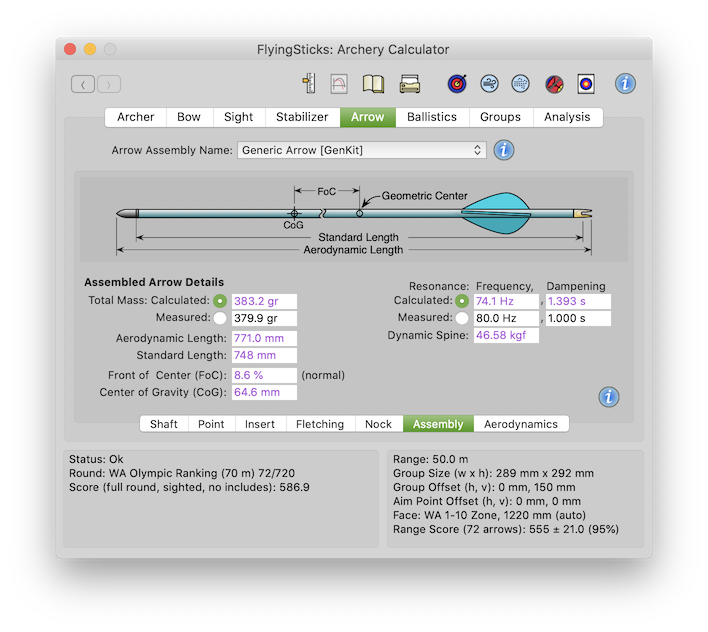 Calculated or
Calculated or  Measured
MeasuredThis panel provides a summary of the assembled arrow physical attributes. Most cannot be modified here as they are calculated fields from previous panels.

 Calculated or
Calculated or  Measured
MeasuredSelect between the Calculated mass (i.e. the sum of the parts) or a
directly Measured value. Note that this selection may be changed to
Calculated from other panel actions where it is sensible to do so. An
example is when spine tuning in the Ballistics>Internal
panel. The field will be in red if the mass is
less than the safe ("dry-fire") mass for the bow - see Bow>Model.
As a matter of trivial detail, the calculated value includes the mass of the enclosed volume of air within the shaft (typically about 0.4 gr) while the measured mass ignores the issue by assuming there is no arrow buoyancy during measurement and is hence included.
Note: the Measured field may be automatically selected and loaded by the Clout Ballistics Optimizer in the Ballistics>Clout panel.
This is the calculated arrow length from tip to tip (nock to point). It is used in various arrow aerodynamic calculations.
This is the calculated arrow length from the nock valley to the back of point (BoP). The BoP is the shoulder where the point mates to the shaft and insert.
This is the calculated FoC commonly used in archery as a measure of an arrow's directional stability. It is the location of the center of gravity (CoG) expressed as a percentage of the arrow's standard length from the arrow's geometric center (based on standard length end points). Normally it should sit between 8% and 20%, and typically 11%. The color of the field will change to red when below 8% indicating a possible dangerous condition.
At best FoC is an approximation for the arrow's Stability Margin presented on the Arrow>Aerodynamics panel. It continues to be used as it is easy to measure, however it ignores the significant aerodynamic contribution of fletching and broadheads.
Following the data field is the FoC catagory commonly used in hunting setups - being one of normal (<12%), high (<19%), extreme (<30%) or ultra (>30%).
This is the distance of the CoG from the arrow's aerodynamic geometric center, expressed in length units.
The following fields define the arrow's natural fundamental resonant frequency. The amplitude of the resonant vibration is set in the Ballistics>Internal panel as it is dependent on bow and release parameters at launch.
 or Measured
or Measured 
These buttons allow the selection of calculated FlyingSticks' estimates or manually entered measured values.
This is the calculated fundamental resonant frequency of the assembled arrow. It is closely related to dynamic spine. The resonant frequency is related to dynamic tuning and is a function of static spine, shaft mass, point mass and arrow length.
The support for this is preliminary and is work in progress.
The resonant vibration of the arrow decays with time. This calculated field shows the estimated time in seconds to decay by 67%. The present model defines a decay time for each shaft material. This is then reduced by an amount related to the point type, fletch area and material.
As for Resonant Frequency, this is work in progress.
This is the arrow's calculated dynamic spine. It is a complicated function of the arrow's stiffness (static spine), length and mass distribution along the shaft. The further mass is away from the nock the greater the reduction in the dynamic spine. See Ballistics>Internal for more on how it is used.
The sectional density is the arrow mass divided by the sectional area of the point. It is a measure of the pressure an arrow can exert on striking a target. Combined with the arrow's speed, the penetration factor (or impact energy density) can be calculated.
Maximize the sectional density by using heavier arrows with small cross-sectional area broadheads.
The formula for sectional density is:
d = m / ( Df2 . π / 4 + (C - Df) . Tb)
where
d is the calculated sectional density
m is total arrow mass
Df is the ferule diameter (or shaft front diameter if it is greater than the ferule's)
C is blade cut width and
Tb is blade thickness